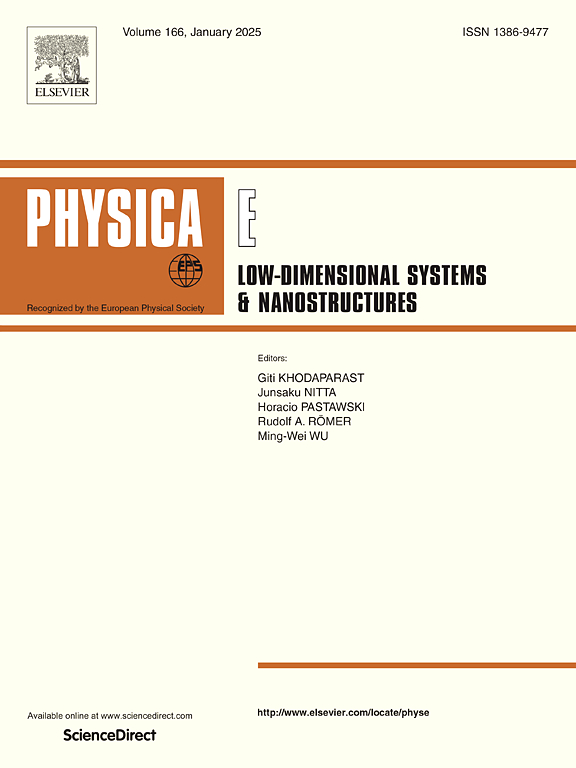二维电子气体中的弗里德尔振荡和具有非库仑杂质势的单层石墨烯
IF 2.9
3区 物理与天体物理
Q3 NANOSCIENCE & NANOTECHNOLOGY
Physica E-low-dimensional Systems & Nanostructures
Pub Date : 2025-07-18
DOI:10.1016/j.physe.2025.116328
引用次数: 0
摘要
我们研究了二维非相互作用电子气体和单层石墨烯中存在单一杂质时的弗里德尔振荡。杂质产生的电势用非库仑相互作用(~ r−η)建模。在线性响应理论中计算了载流子密度偏差作为与杂质距离的函数。我们的研究结果表明,在二维非相互作用的电子气体和石墨烯中,在距离杂质很远的地方,载流子密度振荡的相位不受η参数的影响,η参数表征了相互作用的非库仑性质。η参数只影响该状态下振荡的振幅。用类库仑势(η=1)模拟的杂质的结果在两种情况下都得到了恢复。本文章由计算机程序翻译,如有差异,请以英文原文为准。
Friedel oscillations in a two-dimensional electron gas and monolayer graphene with a non-Coulomb impurity potential
We study Friedel oscillations in a two-dimensional non-interacting electron gas and in a monolayer graphene in the presence of a single impurity. The potential generated by the impurity is modeled using a non-Coulomb interaction (). The charge carrier density deviation as a function of distance from the impurity is calculated within the linear response theory. Our results show that, in both a two-dimensional non-interacting electron gas and graphene, the phase of charge carrier density oscillations remains unaffected by the parameter , which characterizes the non-Coulomb nature of the interaction, at large distances from the impurity. The parameter influences only the amplitude of the oscillations in this regime. The results for an impurity modeled by Coulomb-like potential () are recovered in both cases.
求助全文
通过发布文献求助,成功后即可免费获取论文全文。
去求助
来源期刊
CiteScore
7.30
自引率
6.10%
发文量
356
审稿时长
65 days
期刊介绍:
Physica E: Low-dimensional systems and nanostructures contains papers and invited review articles on the fundamental and applied aspects of physics in low-dimensional electron systems, in semiconductor heterostructures, oxide interfaces, quantum wells and superlattices, quantum wires and dots, novel quantum states of matter such as topological insulators, and Weyl semimetals.
Both theoretical and experimental contributions are invited. Topics suitable for publication in this journal include spin related phenomena, optical and transport properties, many-body effects, integer and fractional quantum Hall effects, quantum spin Hall effect, single electron effects and devices, Majorana fermions, and other novel phenomena.
Keywords:
• topological insulators/superconductors, majorana fermions, Wyel semimetals;
• quantum and neuromorphic computing/quantum information physics and devices based on low dimensional systems;
• layered superconductivity, low dimensional systems with superconducting proximity effect;
• 2D materials such as transition metal dichalcogenides;
• oxide heterostructures including ZnO, SrTiO3 etc;
• carbon nanostructures (graphene, carbon nanotubes, diamond NV center, etc.)
• quantum wells and superlattices;
• quantum Hall effect, quantum spin Hall effect, quantum anomalous Hall effect;
• optical- and phonons-related phenomena;
• magnetic-semiconductor structures;
• charge/spin-, magnon-, skyrmion-, Cooper pair- and majorana fermion- transport and tunneling;
• ultra-fast nonlinear optical phenomena;
• novel devices and applications (such as high performance sensor, solar cell, etc);
• novel growth and fabrication techniques for nanostructures

 求助内容:
求助内容: 应助结果提醒方式:
应助结果提醒方式:


